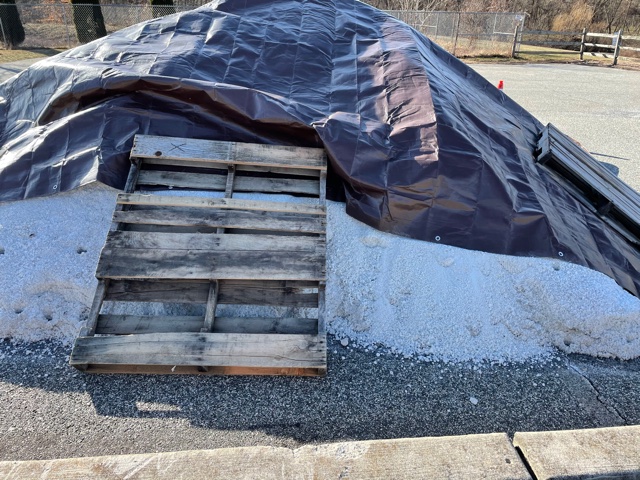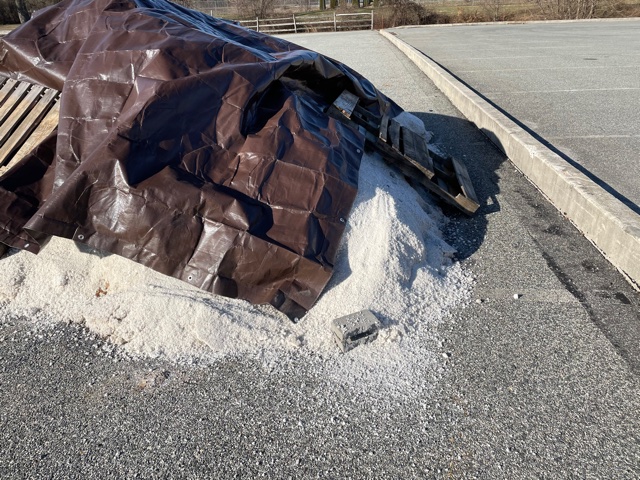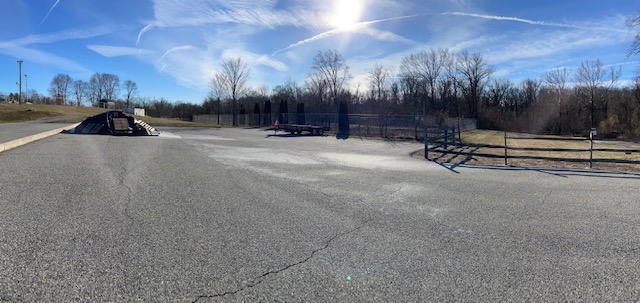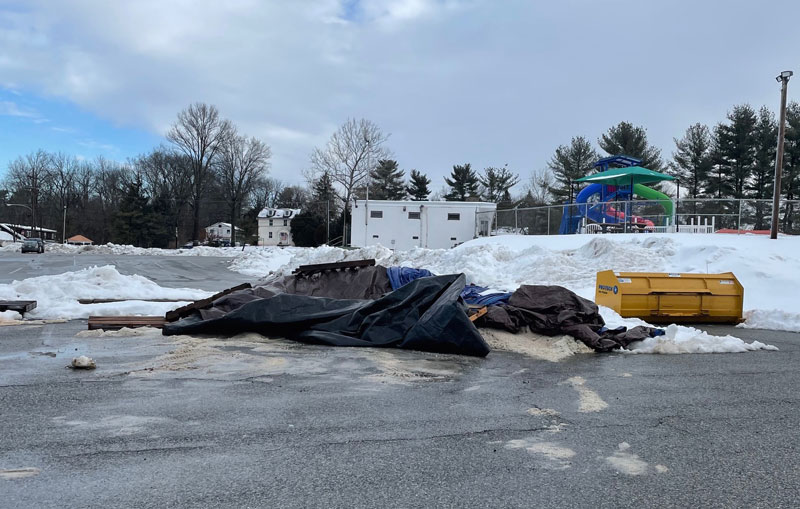In this article I describe the process I have used over the past two years in responding to my field observations of inadequately protected road salt piles during winter in southeastern Pennsylvania.
Some background is needed to make a case for reporting the salt piles, as there is no Pennsylvania regulation on their containment, although there is a regulation on releasing salt to the streams in a concentrated way.
Criteria for Chlorides in Our Fresh Waters
The U.S. Clean Water Act requires that states review and revise their drinking water standards at least once every three years. Pennsylvania’s water quality standard for salt content in drinking water is a maximum level of 250 mg/l. Pennsylvania Department of Environmental Protection (PADEP) has been reviewing criteria for maximum chloride levels for freshwater plant and animal species since the U.S. Environmental Protection Agency (EPA) published Ambient Water Quality Criteria (AWQC for Chloride) in 1988. Still, no changes have been made to date.
EPA standards for the protection of aquatic organisms from the AWQC for Chloride report indicate that organisms are affected if the 4-day average of continuous concentration is more than 230 mg/l more than once every three years on average, and if the 1-hour average concentration is more than 860 mg/l once every three years on average.
EPA finds that the primary anthropogenic sources of chloride (Cl-) are road deicing salts, urban and agricultural runoff, treated industrial waste, discharges from wastewater treatment plants, and chemicals associated with the oil and gas well drilling. These anthropogenic impacts are rapidly changing the chemistry of fresh water, as described and discussed in Kaushal et al., 2019, Novel “chemical cocktails” in inland waters are a consequence of the freshwater salinization syndrome (reference below). The increasing concentration, changing composition, and interactions of chemical mixtures are creating emerging stressor conditions for aquatic biota.
Chloride is toxic to freshwater aquatic life, with some mediators being water pH, alkalinity, hardness, concentration, and water temperature, whereas sulfates increase chloride concentration (Abdel-Wahab and Batchelor, 2006). Furthermore, salt cations such as sodium (Na+), calcium (Ca++), and magnesium (Mg++) have been shown to exhibit toxicity, as well, and contribute to cumulative toxicity effects (Mount et al. 2018).
No Pennsylvania State Codes for Salt Release Limits
In Chester County, Pennsylvania, chloride levels steadily increased in all streams and groundwater between 1998 and 2018, according to Andrew Reif, U.S. Geological Survey (USGS) biologist and specialist in macroinvertebrates. Reif reported to the Valley Creek Restoration Partnership in 2018 that pH has also been steadily increasing, which could mediate the toxic effects of chlorides on aquatic biota. The pH is naturally high in limestone-influenced streams, but he reported the increasing pH could be attributed to direct and indirect anthropogenic effects. Dissolved oxygen has been improving in our streams since the 1990s, associated with water conservation successes, such as improved water treatment plant operations and reduced industrial pollution in Chester County.
Valley Creek had one of the highest dissolved chloride levels collected in the annual Chester County USGS sampling effort, where baseflow levels rose from 54.2 mg/l of chloride in 1998 to 137 mg/l in 2017. EPA water quality criteria for aquatic biota cannot be applied to annual samplings. The 15-minute epoch samplings done by the USGS do not demonstrate the impact of cold weather road salting because the in-stream flow monitoring stations do not operate in the winter months due to potential damage (these sensors cost around $50K in prior years). If the correlation of chloride with conductivity can be used to estimate chloride levels, then the 4-day averages and 1-hour average maximum concentrations could be estimated from conductivity values collected from continuous sensors such as the EnviroDIY Monitoring Stations that are being deployed by watershed groups across the Delaware River Basin.
There are no Pennsylvania state codes for salt release limits. While salt distribution centers require National Pollutant Discharge Elimination System (NPDES) permits for operation, there are no average daily maximum, or instantaneous maximum, concentrations designated for chlorides in effluents, although daily maximum concentrations (mg/l) are to be reported.
Reporting Poorly Protected Salt Piles
There are municipal ordinances in other states that regulate the storage and handling of deicing materials. PADEP requests, but does not require, industry best management practices, stating to one inquirer, “Preventing contact of rainwater and runoff with your salt pile, as well as good housekeeping practices (cleaning up spilled salt) are most important.” I do not know if the state is considering new regulations for salt containment.
Nevertheless, a poorly protected salt pile uphill from a stream, such as the one I will describe here, should be reported to the local township authority and to the PADEP Clean Water Program (at 484-250-5991 or through their website) if the pile is not removed or housed so that there is no risk of runoff. PADEP keeps reporters anonymous.
My recent experience with three of these insufficiently protected piles is that the salt piles are often not removed after the initial report to the municipality, perhaps because the process between local and state governments takes time. In each case, it required sending photos and information (municipality, location, distance to stream if possible) three times.
A facility that finally removed their salt pile after PADEP contacted them then put another larger and more poorly covered salt pile near the same location the following year. After three reports, PADEP visited the site and instructed the workers to adequately cover the pile and shovel the salt back into the pile. PADEP, who reports back to the complaint source, stated that the workers were warned that a fine could follow the next time the pile released salt.




This poorly protected salt pile uphill from a stream was reported to PADEP. The creek of concern is at the tree line.
The problem remained even after PADEP informed the salt pile operators that a fine was possible if handling was inadequate. Water sampling for chloride in various sections of the watershed on that property at the end of the snowstorm showed the chloride level was twice the usual. I followed up with more pictures on two dates a few days apart to show that the problem was persistent and sent them to the township and PADEP. The photos show that even though they used a larger tarp and more pallets, inadequate coverage still threatened the stream.

The poorly maintained salt pile photographed on February 3, 2021. 
The same pile photographed on February 5, 2021.
The main lesson learned is that after the initial communication with the municipality, it is best to contact PADEP directly. This process takes patience with local and state government processes and persistence. Keep aware of weather conditions, pointing out that an imminent rain or snow will cause damage. Take photos of the runoff salt on any surface where it is visible, as seen in the photos here.
In this case, the township thought that the detention basin directly across from the pile would capture the salt, but it did not and the runoff salt burned a large path through the lawn down to the stream. To that end, it can be helpful to take photos and gather information on any aspects that show the importance of preventing runoff to the stream.
By compiling examples of unnecessary salt releases or analyzing our data to identify periods of high chlorides, we might provide enough citizen science data to help PADEP conclude that regulations are needed for salt piles and that salt may endanger freshwater aquatic life. There is no acceptable alternative than persistence. We are awaiting PADEP’s response
References
- Abdel-Wahab A, Batchelor B. 2006. Interactions between chloride and sulfate or silica removals using an advanced lime-aluminum softening process. Water Environ Res. 78(13):2474-9. doi: 10.2175/106143006×102006. PMID: 17243247.
- U.S. Environmental Protection Agency, 1988. Ambient Water Quality Criteria for Chloride -1988. Office of Water Regulations and Standards Criteria and Standards Division, Washington, DC 20460. EPA 440/5-88-001
- Kaushal Sujay S., Likens Gene E., Pace Michael L., Haq Shahan, Wood Kelsey L., Galella Joseph G., Morel Carol, Doody Thomas R., Wessel Barret, Kortelainen Pirkko, Räike Antti, Skinner Valerie, Utz Ryan and Jaworski Norbert. 2019. Novel ‘chemical cocktails’ in inland waters are a consequence of the freshwater salinization syndrome. Phil. Trans. R. Soc. B37420180017
- Mount, D.R., Erickson, R.J., Forsman, B.B., Highland, T.L., Hockett, J.R., Hoff, D.J., Jenson, C.T. and Norberg‐King, T.J. 2019. Chronic toxicity of major ion salts and their mixtures to Ceriodaphnia dubia. Environ Toxicol Chem, 38: 769-783. https://doi.org/10.1002/etc.4346
About the author: Carol Armstrong is a certified Master Watershed Steward and citizen scientist working with Stroud Water Research Center to monitor the health of local waterways and help to ensure a cleaner freshwater future.
We welcome Manage My Watershed members to share their thoughts using the comment form below. Not a member? Register or show your appreciation with the “Like” button. And if you have a watershed story to tell, please share it with our community!
